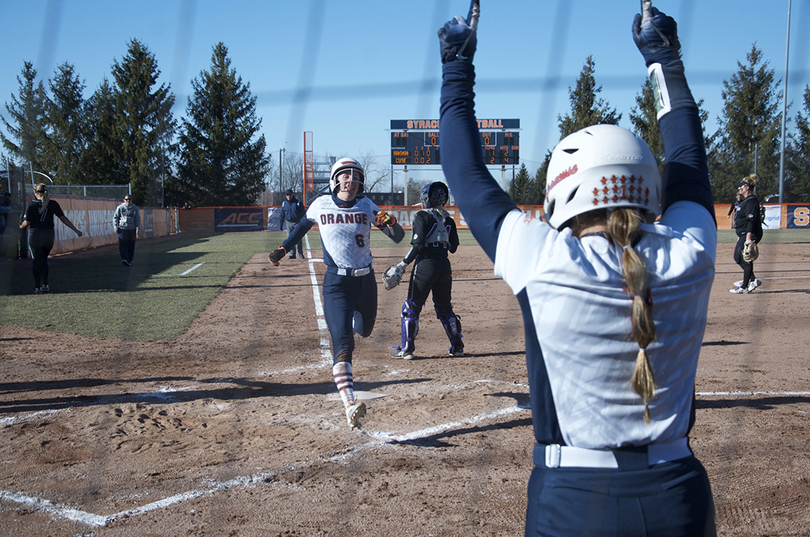How Syracuse tries to steal signs, pick pitches from opponents

Syracuse celebrates as a runner crosses the plate. Josh Schafer | Senior Staff Writer
Whenever Syracuse head coach Shannon Doepking yells “sit” to the SU hitter while an opposing pitcher is in her windup, the Orange hitters know what to expect.
“Sit” is a signal to hitters that a changeup is coming. Against North Carolina State last weekend, Doepking’s vantage point down the third baseline allowed her to notice small tendencies in the pitcher’s motion and grip. The simple three-letter word tipped off Orange hitters, and instead of anticipating a fastball, they sat back for a changeup, assistant coach Vanessa Shippy said.
“The more you see it coming, the better our hitters will be,” Shippy said. “She (Doepking) called it almost every time and you can tell it gets in the pitcher’s head a little bit.”
Syracuse (17-20, 6-6 Atlantic Coast) has stolen signs from opposing pitchers in at least two of its last three series, coaches said. It has also studied pitchers’ deliveries and grips out of their hand. When the Orange are able to identify a pitch based on in-game patterns, SU can rattle the pitcher and gain a tangible edge at the plate. In their last 10 games (eight wins), the Orange have averaged 7.1 runs per game, almost three runs more than the 4.36 they averaged in 2018.
Two years ago, the NCAA allowed pitchers and defenders to wear wristbands as an attempt to prevent stealing signs. This season, the first under Doepking, Syracuse is paying for a service that maximizes the wristband strategy.
Each week, pitching coach Miranda Kramer provides the weekly code for the SU pitching staff to wear on their wristbands. On each is a chart of numbers that randomly rotate each week to keep opponents off-guard. The numbers indicate pitch selection and location. The Orange’s corner infielders then adjust accordingly.
“A couple years ago, it got pretty common in softball where you started picking signs,” Doepking said. “You write down sequences, you can pick signs and the batters know what’s coming.”
The wristband reads: “Never miss a sign.” It can hold up to 100 numbers at a time, and while it’s supposed to be an “unpickable” system to unlock, Doepking said that the Orange have stolen a few signs this season, including Boston College’s from March 22-24.
While the Orange hitters are constantly trying to get an edge, the SU pitchers are aware of it, too. When Alexa Romero started pitching in middle school, she always gripped the ball outside of her glove, and until high school, she faced no issues. But in her sophomore year, a coach told her that she would need to better hide the ball in her glove to prevent opposing hitters and coaches from reading the ball and anticipating pitches.
“No one ever really (hid the ball) where I was from,” Romero said of the change in pitching windup. “They thought it was difficult because you have to have the ball in your glove to get your grip, and that’s harder to do. You can’t really see my pitches.”
Romero said she’s not a part of the pitch-tipping and sign-stealing operation when Syracuse is hitting, but she’ll often sit and watch the opposing pitcher, trying to read her. She’s enjoyed “predicting” pitches. Then, she’ll talk with Kramer, who also tracks pitches, to see if she was right or not.
Each week in film review, the Orange study the opposing pitchers in slow motion. Some pitchers have slight indications that can only be seen in super slow motion, Shippy said. Footwork, ball grips and glove positioning can key a batter, Doepking said. Once each SU hitter has faced a pitcher once, they’ll recognize spins and tendencies, said senior Bryce Holmgren.
But there’s a fine line. Holmgren will try to read whether or not the pitch will be higher in the zone or lower and if it’s going to be off-speed or not. But most importantly, with such little reaction time, she’s more focused on what she can control.
“There’s a delicate balance between trying to read the ball and the spin out of the pitcher’s hand and trying not to overthink it,” Holmgren said.




